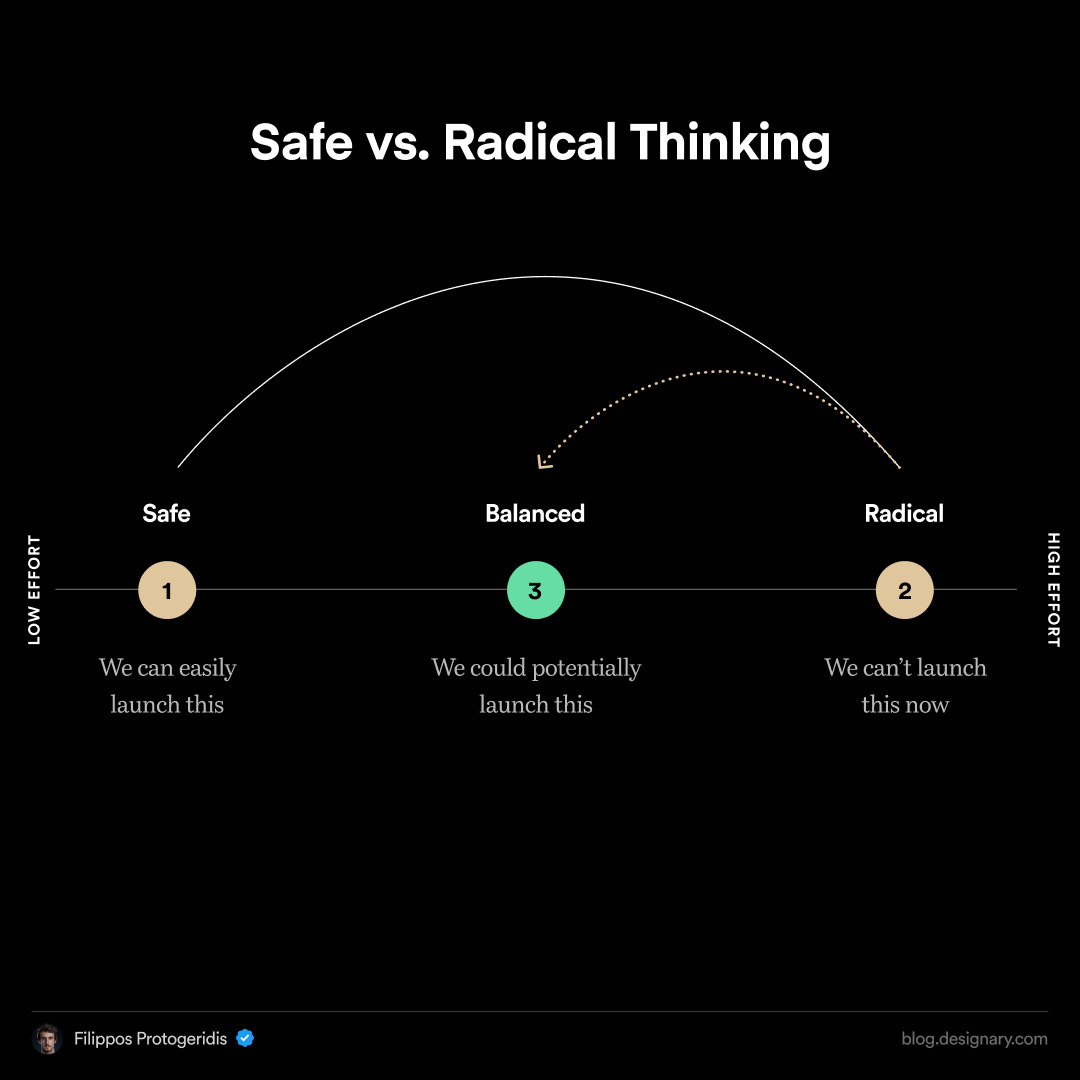Safe vs. Radical Thinking
A simple mental model to spark innovation in product design
👋 Hey, it’s Filippos! Welcome to this issue of the Designary newsletter. If you are new here, I write about product design, including career advice, UX tips, frameworks, and thoughts on product in general. I also run a product design challenge monthly.
I have a simple tip I use to reinforce design innovation on a daily basis.
It's called Safe vs. Radical Thinking, a mental model you can apply whenever you are thinking of solutions for a given problem.
The dangerous habit of opting for quick wins
In most cases, working in fast-paced environments means product designers often opt for quick-win “MVP” solutions.
Product Managers are often happy with that approach: it means the team can deliver at a good pace while still managing to gradually move key metrics.
But this mentality can create a dangerous habit of always thinking of the safest ideas; ideas that can be launched quickly without too much effort.
And then the big, bold, radical ideas never see the light of day.
Thinking safe, then radical
To break out of that habit loop, we need to allow ourselves to think of bold ideas.
In order to do this, whenever I need to come up with a design approach for a given problem, I think of (minimum) three different ideas:
A safe one — "What would I do if we needed to launch ASAP?"
A radical one — "What would I do if there were no constraints?"
A balanced, middle-ground option — "What if there is a compromise between the two?"
The safe idea
“What would I do if we needed to launch something as quickly as possible?”
I often start with the safe idea.
That's often a combination of using existing flows and components and sticking to what has already worked for the product in the past.
I like to think of safe ideas as a baseline on which to improve rather than the default suggested route.
The radical idea
I then push myself to think of a radical idea.
“What would I do if there were no constraints? What if we had all the time, capacity and resources to build anything that would solve the problem?”
This idea may leverage new tech, require operational changes, or be fairly challenging to deliver.
In most cases, ideas like that are completely disregarded and moved to the bottom of a backlog that no one ever checks.
However, radical thinking does a few things:
It pushes designers out of their comfort zone
It sparks a lot of creativity due to boundaries being removed
And, very importantly, it creates the opportunity for a middle-ground area:
The balanced, middle-ground idea
"Is there a way I can combine elements of the two or create a middle-ground solution?
In many cases, parts of the radical idea can be tested earlier on.
More importantly, the creative thinking involved in coming up with a radical idea sparks some interesting, shorter-term ideas that the team can launch without all the added effort.
Anecdotally, I find that the best product ideas are produced in this middle-ground area after some safe vs. radical thinking has taken place.
In summary
Whenever you are tasked with finding a design solution to a problem, try to think of three different ideas: a safe, a radical, and a balanced option.
Using that thinking model will do the following:
It will help you be more creative within logical boundaries.
It will help your team exit the rabbit hole of only going for the quickest solutions.
It will help develop your short vs. long-term thinking.
Hope you found this entry useful! If you have any additional thoughts, let me know in the comments 👇



This is very helpful, but do you always needs to apply this mental model?
Like in some cases if the requirement is obvious/standard, do you still follow this?
eg. if we need to give the user to opt-in for a particular need.
The ideal/standard solution is a checkbox.
Do we really want to reinvent the wheel?